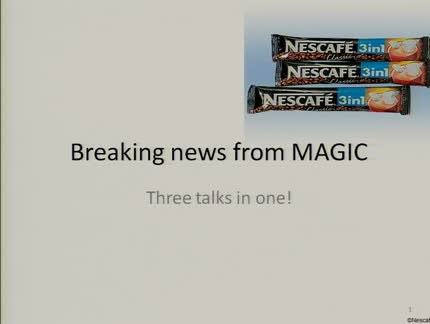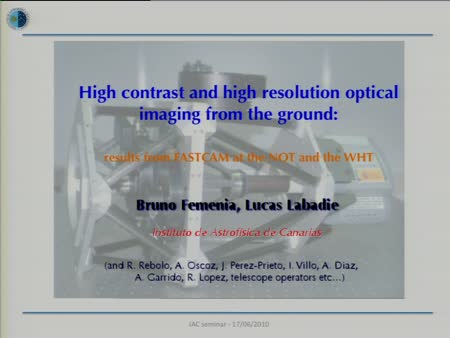Found 111 talks archived in Telescopes and instrumentation

Abstract
In recent years, many countries throughout the Middle East - in particular the more prosperous states - have made great progress in education, higher education, and scientific research. However, this has not often been matched by equivalent progress in astronomy and its related fields, despite the fact that many nations in the region consider astronomy a fundamental part of their cultural and scientific heritage. The current status of astronomy in the individual countries of the Middle East will be reviewed. The positive decision of the International Astronomical Union (IAU) (Commission 46) to take a proactive role through visits and consultancy in the region will also be discussed, including the founding of MEARIM - the Middle East and Africa Regional IAU Meeting (first meeting held in Cairo 2008). The challenges and proposals to move forward teaching and research in astronomy in the Middle East will be considered, with comments relating North African countries and new trends, including space research along with astronomical activities.

Abstract
3C 279, the first quasar discovered to emit VHE gamma-rays by the MAGIC telescope in 2006, was re-observed by MAGIC in January 2007 during a major optical flare and from December 2008 to April 2009 following an alert from the Fermi space telescope on an exceptionally high gamma -ray state. The January 2007 observations resulted in a detection on January 16 with significance 5.2 sigma, corresponding to a F(> 150 GeV)(3.8±0.8) 10^-11 ph cm-2 s-1 while the overall data sample does not show significant signal. The December 2008 - April 2009 observations did not detect the source. We study the multi-wavelength behaviour of the source at the epochs of MAGIC observations, collecting quasi-simultaneous data at optical and X-ray frequencies and for 2009 also gamma-ray data from Fermi. We study the light curves and spectral energy distribution of the source. The spectral energy distributions of three observing epochs (including the February 2006, which has been previously published in Albert et al. 2008a) are modelled with one-zone inverse Compton models and the emission on January 16, 2007 also with two zone model and with a lepto-hadronic model. We find that the VHE gamma-ray emission detected in 2006 and 2007 challenges standard one-zone model, based on relativistic electrons in a jet scattering broad line region photons, while the other studied models fit the observed spectral energy distribution more satisfactorily.

Abstract
CANARY is a technical demonstrator for the proposed EAGLE instrument for European ELT. EAGLE will have twenty Integral Field Units patrolling a 5 arcminute field and requires a new form of adaptive optics to provide the required image quality for its 0.0375 arcsec image sampling: Laser Guide Star Multi-Object AO. This entails several significant technical innovations: open-loop control, atmospheric tomography, and new calibration methods. The CANARY demonstrator is currently in its first, natural guide star, phase, and the first results have been obtained on sky. CANARY Phase A is described and the first results are presented. The next, laser guide star, phase is then outlined.

Abstract
A new method of imaging in the visible has given the highest resolution images ever taken anywhere. It needs a natural guide star of only 18.5 mag (I band). This talk will show how it can be done on the WHT, the VLT and even on the GTC.
Abstract
Developed since 2006 by the IAC and UPCT, FASTCAM is an optical camera which takes advantage of recently available low noise and fast read-out CCDs (with integration times ~30 ms) to perform speckle imaging of astrophysical sources. At high enough speed rate, the atmospheric turbulence - classically responsible for image degradation , i.e. seeing- can be frozen in the image, which permits us to implement "lucky imaging techniques". In this shared talk, we will review the principle and objectives of the instrument (mainly oriented so far towards the study of brown dwarfs), we will present the results obtained in different campaigns at the NOT and WHT telescopes stressing the effort towards high contrast and high resolution optical imaging potential which can be further enhanced with post-processing techniques. In this talk we will also discuss some ideas for future projects and scientific applications, possibly in conjunction with the GTC.
Abstract
I will present a short introduction to speckle imaging and the so-called speckle holography technique. Subsequently, I will present results of speckle observations with the VLT (NACO) and Keck (NIRC) telescopes. The experiments demonstrate that in the observed targets speckle imaging combined with holographic image reconstruction provides imaging quality that can compete with and even supersede current adaptive optics (AO) imaging systems. Speckle imaging is a way to achieve reliable, high-quality, diffraction limited imaging capacity at relatively low costs. I will discuss what would be the estimated performance of speckle cameras at the WHT and GTC and sketch possible concepts.
Abstract
Teams from industry, universities and institutes across Europe are contributing to the design and development phase of the European Southern Observatory's project to build the world's biggest optical/infrared telescope. I will outline some of exciting scientific prospects for a fully-adaptive 42m telescope, from studying exoplanets to the furthest galaxies, and then show how some of the technical challenges are being addressed. I will place special emphasis on the work UK teams are doing on instrumentation, detectors and adaptive optics.
Abstract
The SONG SONG (Stellar Observations Network Group) project is a worldwide initiative to design and build a global network of 1m telescopes (6 to 8 nodes) to allow observations with a high duty cycle (> 80%) and near continuous coverage over long time spans (weeks to months). The SONG prototype (first node of the network) is currently under construction and it is expected to be placed at the Observatorio del Teide in mid 2011 on the basis of a bilateral collaborative agreement. The main scientific goals for SONG are to study stars using asteroseismology, and to search for, and characterize, extra-solar planets using microlensing and radial-velocity observations. In order to achieve this, the prototype node will be equipped with a high-resolution spectrograph and a dual-colour lucky-imaging camera. Here we describe the main aspects of the project and the various scientific opportunities that will be offered to the Spanish community.
Abstract
The main goal of the MASTER-Net project is to produce a unique fast sky survey with all sky observed over a single night down to a limiting magnitude of 21. Such a survey will make it possible to address a number of fundamental problems: search for dark energy via the discovery and photometry of supernovae (including SNIa), search for exoplanets, microlensing effects, discovery of minor bodies in the Solar System, and space-junk monitoring. All MASTER telescopes can be guided by alerts, and we plan to observe prompt optical emission from gamma-ray bursts synchronously in several filters and in several polarization planes.
Abstract
I present the online and the offline data reduction system for OSIRIS, the optical multi-mode instrument for GranTeCan. The software is written in Python and invokes PyRAF tasks which have been optimized for the instrument. I review the characteristics of the instrument and of the software. I will also present the improvements which are foreseen for the software.Upcoming talks
- TODAY: EMO-1: Construyendo un observatorio caseroEnol Matilla BlancoFriday April 19, 2024 - 10:30 GMT+1 (Aula)
- Classical Be stars - Constraining binary interaction physics in massive starsDr. Julia BodensteinerThursday April 25, 2024 - 10:30 GMT+1 (Aula)








